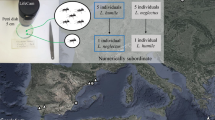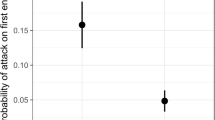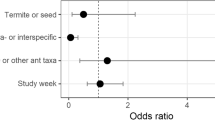Abstract
The Argentine ant Linepithema humile (Dolichoderinae) is one of the most widespread invasive ant species in the world. Throughout its introduced range, it is associated with the loss or reduced abundance of native ant species. The mechanisms by which these native species are displaced have received limited attention, particularly in Australia. The role of interference competition in the displacement of native ant species by L. humile was examined in coastal vegetation in central Victoria (southeastern Australia). Foragers from laboratory colonies placed in the field consistently and rapidly displaced the tyrant ant Iridomyrmex bicknelli, the big-headed ant Pheidole sp. 2, and the pony ant Rhytidoponera victoriae from baits. Numerical and behavioural dominance enabled Argentine ants to displace these ants in just 20 min; the abundance of native species at baits declined 3.5–24 fold in direct relation to the rapid increase in L. humile. Most precipitous was the decline of I. bicknelli, even though species in this typically dominant genus have been hypothesized to limit invasion of L. humile in Australia. Interspecific aggression contributed strongly to the competitive success of Argentine ants at baits. Fighting occurred in 50–75% of all observed interactions between Argentine and native ants. This study indicates that Argentine ants recruit rapidly, numerically dominate, and aggressively displace from baits a range of Australian native ant species from different subfamilies and functional groups. Such direct displacement is likely to reduce native biodiversity and indirectly alter food web structure and ecosystem processes within invaded areas. Biotic resistance to Argentine ant invasion from native ants in this coastal community in southeastern Australia is not supported in this study.
Similar content being viewed by others
References
Andersen AN (1986a) Diversity, seasonality and community organisation of ants at adjacent heath and woodland sites in south-eastern Australia. Aust J Zool 34:53–64
Andersen AN (1986b) Patterns of ant community organisation in mesic south-eastern Australia. Aust J Ecol 11:87–98
Andersen AN (1990) The use of ant communities to evaluate change in Australian terrestrial ecosystems: a review and a recipe. Proc Ecol Soc Aust 16:347–357
Andersen AN (1992) Regulation of “momentary” diversity by dominant species in exceptionally rich ant communities of the Australian seasonal tropics. Am Natural 140:401–420
Andersen AN (1997) Functional groups and patterns of organization in North American ant communities: a comparison with Australia. J Biogeogr 24:433–460
Andersen AN, Patel AD (1994) Meat ants as dominant members of Australian ant communities: an experimental test of their influence on the foraging success and forager abundance of other species. Oecologia 98:15–24
Bond W, Slingsby P (1984) Collapse of an ant-plant mutualism the Argentine ant Iridomyrmex humilis and myrmecochorous Proteaceae. Ecology 65:1031–1037
Calder WB (1975) Peninsula perspectives. WB Calder, Melbourne, Australia
Cole FR, Medeiros AC, Loope LL, Zuehlke WW (1992) Effects of the Argentine ant on arthropod fauna of Hawaiian high-elevation shrubland. Ecology 73:1313–1322
Crowell KL (1968) Rates of competitive exclusion by the Argentine ant in Bermuda. Ecology 49:551–555
Davidson DW (1998) Resource discovery versus resource domination in ants: a functional mechanism for breaking the trade-off. Ecol Entomol 23:484–490
De Kock AE (1990) Interactions between the introduced Argentine ant, Iridomyrmex humilis Mayr, and two indigenous fynbos ant species. J Entomol Soc South Africa 53:107–108
Erickson JM (1971) The displacement of native ant species by the introduced Argentine ant Iridomyrmex humilis Mayr. Psyche 78:257–266
Fellers JH (1987) Interference and exploitation in a guild of woodland ants. Ecology 69:1466–1478
Fox BJ, Fox MD, Archer E (1985) Experimental confirmation of competition between two dominant species of Iridomyrmex (Hymenoptera:Formicidae). Aust J Ecol 10:105–110
Fluker SS, Beardsley JW (1970) Sympatric associations of three ants: Iridomyrmex humilis, Pheidole megacephala, and Anoplolepis longipes in Hawaii. Ann Entomol Soc Am 63:1290–1296
Gibb H, Hochuli DF (2004) Removal experiment reveals limited effects of a behaviorally dominant species on ant assemblages. Ecology 85:648–657
Giraud T, Pedersen JS, Keller L (2002) Evolution of supercolonies: the Argentine ants of Southern Europe. Proc Natl Acad Sci USA 99:6075–6079
Greenslade PJM (1976) The meat ant Iridomyrmex purpureus (Hymenoptera:Formicidae) as a dominant member of ant communities. J Aust Entomol Soc 15:237–240
Greenslade PJM (1978) Ants. In: Low A (ed) The physical and biological features of Kunnoth in Central Australia. CSIRO Division of Land Resources Management Technical Paper No. 4
Greenslade PJM, Halliday RB (1982) Distribution and speciation in meat ants, Iridomyrmex purpureus and related species (Hymenoptera:Formicidae). In: Barker WR, Greenslade PJM (eds) Evolution of the Flora and Fauna of Arid Australia. Peacock Publications, Adelaide, pp 249–255
Greenslade PJM, Halliday RB (1983) Colony dispersion and relationships of meat ants Iridomyrmex purpureus and allies in an arid locality in South Australia. Insect Sociaux 30:82–99
Haines IH, Haines JB (1978) Pest status of the crazy ant, Anoplolepis longipes (Jerdon) (Hymenoptera:Formicidae), in the Seychelles. Bull Entomol Res 68: 627–638
Haskins CP, Haskins EF (1988) Final observations on Pheidole megacephala and Iridomyrmex humilis in Bermuda. Psyche 95:177–183
Hee JJ, Holway DA, Suarez AV, Case TJ (2000) Role of propagule size in the success of incipient colonies of the invasive Argentine ant. Conserv Biol 14:559–563
Heller NE (2004) Colony structure in introduced and native populations of the invasive Argentine ant, Linepithema humile. Insect Sociaux 51:378–386
Hoffmann BD, Andersen AN, Hill GJE (1999) Impact of an introduced ant on native rain forest invertebrates: Pheidole megacephala in monsoonal Australia. Oecologia 120:595–604
Hölldobler B, Wilson EO (1990) The Ants. Belknap Press, Cambridge
Holway DA (1998a) Effect of Argentine ant invasions on ground-dwelling arthropods in northern California riparian woodlands. Oecologia 116:252–258
Holway DA (1998b) Factors governing rate of invasion: a natural experiment using Argentine ants. Oecologia 115:206–212
Holway DA (1999) Competitive mechanisms underlying the displacement of native ants by the invasive Argentine ant. Ecology 80:238–251
Holway DA (2005) Edge effects of an invasive species across a natural ecological boundary. Biol Conserv 121:561–567
Holway DA, Case TJ (2001) Effects of colony-level variation on competitive ability in the invasive Argentine ant. Anim Behav 61:1181–1192
Holway DA, Suarez AV, Case TJ (1998) Loss of intraspecific aggression in the success of a widespread invasive social insect. Science 283:949–952
Holway DA, Suarez AV, Case TJ (2002a) Role of abiotic factors in governing susceptibility to invasion: a test with Argentine ants. Ecology 83:1610–1619
Holway DA, Lach L, Suarez AV, Tsutsui ND, Case TJ (2002b) The causes and consequences of ant invasions. Ann Rev Ecol System 33:181–233
Hughes L, Westoby M (1992) Fate of seeds adapted for dispersal by ants in Australian sclerophyll vegetation. Ecology 73:1285–1299
Human KG, Gordon DM (1996) Exploitation and interference competition between the invasive Argentine ant, Linepithema humile, and native ant species. Oecologia 105:405–412
Human KG, Gordon DM (1999) Behavioral interactions of the invasive Argentine ant with native ant species. Insect Sociaux 46:159–163
Human KG, Weiss S, Weiss A, Sandler B, Gordon DM (1998) Effects of abiotic factors on the distribution and activity of the invasive Argentine ant (Hymenoptera:Formicidae). Environ Entomol 27:822–833
Le Breton J, Chazeau J, Jourdan H (2003) Immediate impacts of invasion by Wasmannia auropunctata (Hymenoptera:Formicidae) on native litter ant fauna in a New Caledonian rainforest. Austral Ecol 28:204–209
Lieberburg I, Kranz PM, Seip A (1975) Bermudian ants revisited: the status and interaction of Pheidole megacephala and Iridomyrmex humilis. Ecology 56:473–478
Majer JD (1994) Spread of Argentine ants (Linepithema humile), with special reference to Western Australia. In: Williams DF (ed) Exotic ants: biology, impact, and control of introduced species, Westview Press, Boulder, CO, pp163–173 and 332
Morrison LW (2000) Mechanisms of interspecific competition among an invasive and two native fire ants. Oikos 90:238–252
Ness JH, Bronstein JL, Andersen AN, Holland JN (2004) Ant body size predicts dispersal distance of ant-adapted seeds: implications of small-ant invasions. Ecology 85:1244–1250
Newell W, Barber TC (1913) The Argentine ant. Bureau Entomol Bull 122:1–98
Pamilo P, Crozier RH, Fraser J (1985) Inter-nest interactions, nest autonomy, and reproductive specialization in an Australian arid-zone ant, Rhytidoponera sp 12. Psyche 92:217–236
Porter SD, Savignano DA (1990) Invasion of polygyne fire ants decimates native ants and disrupts arthropod community. Ecology 71:2095–2106
O’Dowd DJ, Green PT, Lake PS (2003) Invasional ‘meltdown’ on an oceanic island. Ecol Lett 6: 812–817
Quinn GP, Keough MJ (2002) Experimental design and data analysis for biologists. Cambridge University Press, Cambridge, UK
Rodgerson L, (1998) Mechanical defense in seeds adapted for ant dispersal. Ecology 79:1669–1677
Roulston TH, Buczkowski G, Silverman J (2003) Nestmate discrimination in ants: effect of bioassay on aggressive behavior. Insect Sociaux 50:151–159
Rowles AD (2005) Invasion by Argentine ants (Linepithema humile) in southeastern Australia: direct and indirect effects and mechanisms for impacts. PhD thesis, Monash University, Australia, p 231
Sanders NJ, Gotelli NJ, Heller NE, Gordon DM (2003) Community disassembly by an invasive species. Proc Natl Acad Sci USA 100:2474–2477
Shattuck SO (1992a) Generic revision of the ant subfamily Dolichoderinae (Hymenoptera:Formicidae). Sociobiology 21:1–181
Shattuck SO (1992b) Review of the Dolichoderine ant genus Iridomyrmex Mayr with descriptions of three new genera (Hymenoptera:Formicidae). J Aust Entomol Soc 31:13–18
Shattuck SO (1999) Australian ants their biology and identification. CSIRO, Collingwood, Victoria, Australia
Suarez AV, Richmond JQ, Case TJ (2000) Prey selection in horned lizards following the invasion of Argentine ants in southern California. Ecol Appl 10:711–725
Suarez AV, Tsutsui ND, Holway DA, Case TJ (1999) Behavioral and genetic differentiation between native and introduced populations of the Argentine ant. Biol Invas 1:43–53
Thomas ML, Holway DA (2005) Condition-specific competition between invasive Argentine ants and Australian Iridomyrmex. J Anim Ecol 74:532–542
Touyama Y, Ogata K, Sugiyama T (2003) The Argentine ant, Linepithema humile, in Japan: assessement of impact on species diversity of ant communities in urban environments. Entomol Sci 6:57–62
Tsutsui ND, Suarez AV, Holway DA, Case TJ (2000) Reduced genetic variation and the success of an invasive species. Proc Natl Acad Sci USA 97:5948–5953
Tsutsui ND, Suarez AV, Holway DA, Case TJ (2001) Relationships among native and introduced populations of the Argentine ant (Linepithema humile) and the source of introduced populations. Mol Ecol 10:2151–2161
Walters AC, Mackay DA (2005) Importance of large colony size for successful invasion by Argentine ants (Hymenoptera:Formicidae): evidence for biotic resistance by native ants. Austral Ecol 30:395–406
Walters AC (in press) The invasion of Argentine ants (Hymenoptera:Formicidae) in South Australia: impacts on community composition and abundance of invertebrates in urban parklands. Austral Ecol 31
Ward PS (1981) Ecology and life history of the Rhytidoponera impressa group (Hymenoptera:Formicidae) I Habitats, nest sites, and foraging behavior. Psyche 88:89–108
Wilkinson L (2000) SYSTAT 10. SPSS Inc, Chicago, Illinois
Acknowledgements
We thank J. Majer, J. Silverman and K. Abbott for comments on an earlier draft and B. Rowles-van Rijswijk for manuscript review and field assistance. T. Craven and P. Davis provided advice on extraction of ants from soil. D. Mackay, M. Burd and M. Thomas advised on the design of laboratory ant colonies. Parks Victoria provided access to sites in the Mornington Peninsula National Park under permit no. 10002268. This is contribution no. 102 from the Australian Centre for Biodiversity: Analysis, Policy and Management at Monash University.
Author information
Authors and Affiliations
Corresponding author
Rights and permissions
About this article
Cite this article
Rowles, A.D., O’Dowd, D.J. Interference competition by Argentine ants displaces native ants: implications for biotic resistance to invasion. Biol Invasions 9, 73–85 (2007). https://doi.org/10.1007/s10530-006-9009-5
Received:
Accepted:
Published:
Issue Date:
DOI: https://doi.org/10.1007/s10530-006-9009-5




